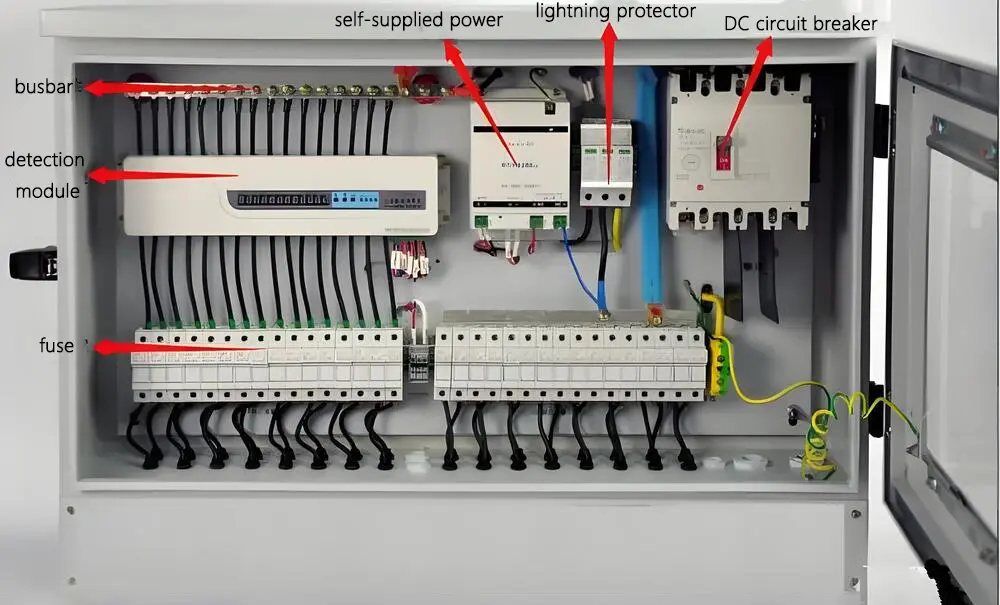2025-03-25
Have you ever looked at a solar panel array and been curious about how all of those individual solar modules manage to efficiently share their power with the inverter? The answer lies in the PV combiner box. But what is a PV combiner box, and why is it necessary in a photovoltaic (PV) system?
A PV combiner box is an electrical enclosure that collects the output of multiple solar panels prior to passing it on to the inverter. It makes wiring more convenient, ensures safety, and improves the performance of the system. Whether installing a small domestic solar array or a big commercial PV installation, the combiner box plays an essential role in ensuring maximum energy output.
A PV combiner box serves as a convergence point of an array of panel strings to be connected together. It aggregates some of the most essential items for an electrical system to be secure and safe. Below are its main functions:
Each solar panel generates direct current (DC) electricity. Where multiple panels are installed, they are typically wired in strings. The combiner box takes output from the strings and sums it into single DC output, which is fed to the inverter.
Since multiple strings are combined, there is a risk of electrical faults or overloads. Combiner boxes are thus fitted with overcurrent protection devices such as circuit breakers or fuses. These devices help ensure that such damage from excessive current cannot be done.
Combiner boxes may also be fitted with disconnect switches, allowing the solar array to be shut off for maintenance or emergency situations by system operators. Surge protection devices (SPDs) also offer protection against lightning or grid disturbance-caused voltage spikes.
Without a combiner box, each solar panel string would need to be separately wired to the inverter, increasing the likelihood of electrical faults and complicating installation. Bundling multiple strings together, the combiner box minimizes the number of cables required, creating neater installations and lower labor costs.

A properly designed solar combiner box typically includes:
A PV combiner box is usually located between solar panels and inverter. The specific location is system size and design dependent:
If you’re wondering whether a combiner box is really necessary, consider these benefits:
Fewer individual cables running to the inverter means a more organized and manageable installation.
With inherent circuit protection and disconnect switches, combiner boxes avoid electrical hazards and facilitate safe system maintenance.
Wiring simplification and improved efficiency translate into reduced installation expenses and an increase in system dependability, therefore entailing less maintenance expenditure.
System owners are able to monitor power output and diagnose faults in real time using improved combiner boxes with monitoring function.
Assuming you have a home solar system with 12 solar panels with 40V and 8A output. If the panels are wired into four strings with three panels in each string, their combined output needs to be regulated safely before reaching the inverter.
The solar industry is constantly evolving, and the combiner boxes are not behind. Some of the emerging trends are:
New combiner boxes are being equipped with IoT-based monitoring, allowing users to remotely monitor system performance and detect faults before they cause failures.
Due to the growing incidence of severe weather, manufacturers are making surge protection devices (SPDs) stronger for protection from power surges caused by lightning or grid instability.
Newer combiner boxes have modular designs, which make them easy to scale up or reconfigure for different solar installations.
You will not need a combiner box if you are putting in a small off-grid system with limited panels. However, bigger residential, commercial, or utility installations require a combiner box for:
So, the next time you lay eyes on a big solar farm or even a residential solar system, ask yourself—how is all that power efficiently making its way to the inverter? Chances are, there's a combiner box behind the scenes making it possible!
Tags:
Shanghai Huijue Solar Carport Project

Small Commercial Energy Storage System Project for Singapore Manufacturing Companies

China Hunan Province Scenic Area Microgrid System Project

Northern Europe Commercial Center Outdoor Cabinet Industrial and Commercial Energy Storage System Project

Large Container Energy Storage System in Sichuan, China